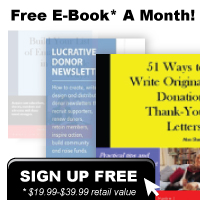The three essentials – the outer envelope, the reply form and the return envelope.
1. Every fundraising package must have one: THE OUTER ENVELOPE
Your outer envelope is critical. No matter how heart-warming your story or compelling your letter or noble your cause, it is all to no avail if the envelope doesn’t get opened. That decision – to open or not to open – is made in just 2 or 3 seconds. And sadly, most direct mail envelopes lose that decision. They get tossed without even being opened. And that includes fundraising envelopes.
Of course if you are mailing to existing donors, this is not the case. Your donors will open just about anything you send them. But when you are doing an acquisition mailing, your envelope is the vital first step in getting a new donor. In fact, your envelope strategy is so important we’ll soon be devoting a newsletter entirely to it.
The two workhorse outers for fundraising are the #10 (9 1/2 x 4 1/8) and the #8 (6 1/2 x 3 5/8) window envelopes. Sometimes, if the situation calls for it, another approach, such as a 6 x 9, a 9 x 12 or invitation type of envelope can be effective.
The big question is, should your envelope have teaser copy on it? This is one of those situations that can be answered only through testing. The only thing you can assume with reasonable certainty is that a plain envelope will probably work better than an envelope with “lame” teaser copy. Simply, no teaser is usually better than a lousy teaser.
2. You have to offer them an easy way to give you their gift: the REPLY FORM
It is critical to personalize the reply form so the person merely has to fill in their credit card number or enclose a check. This is far more important than personalizing the letter because it makes responding so much easier.
If you want to personalize both the letter and the reply form, you can it do it economically by using 8 ½ x 14 paper and creating a perfed 8 ½ x 3 reply form at the bottom of the letter. Letter and reply form can then be personalized and printed at the same time. Just be sure to design it so that the address shows through your outer envelope window.
3. You have to give them an easy way to send their gift: the BRE and CRE
You want to make it easy to respond so a reply envelope should always be included. It’s worth testing whether you should use a BRE with postage paid or a CRE where the responder has to use their own stamp. If the response with the CRE is close to that with the BRE, it will likely pay to use the CRE, considering you have to pay first-class postage plus a handling fee for each envelope you receive back.
Two extra steps you can take with the reply envelope are . . .
Print on the front of the BRE or CRE “To the attention of . . ” or “Please forward to . .” [the person who signed the letter]. It adds a touch of immediacy and urgency.
On the BRE, the words “Your stamp will save us money” under the postage-paid indicia, will motivate some responders to apply their own stamp.
Two common non-essentials: the BROCHURE and LIFT LETTER
When do you need a brochure? Certainly not all the time. Tests have shown that a brochure can actually depress response because it can take readership away from the letter. A person will spend only so much time with a direct mail package. If too much time is spent with a brochure, that takes time away from the letter. And since the letter is the strongest sales tool, response can fall. In fundraising, the old adage “the brochure tells, the letter sells” is particularly true. The key to response is to appeal to emotion, and the letter format does that better than a brochure.
An effective brochure could be a report printed on inexpensive paper showing how funds raised are spent. Or if your cause has been written about in the media, articles reprinted on newsprint add big impact and cost little. Your brochure solution may be as simple as adding a photocopied article into the package with a handwritten blurb at the top.
There are some situations where a brochure may be necessary. For example . . .
- If you have to teach the reader
- If you have too much necessary information for a letter
- If there are photos or visuals that will help your case
Bottom line – you should probably test to see if you need it.
And finally, the other common component is the lift letter. Unlike the brochure, the lift letter can be used to appeal to emotion and it usually works to lift response. My experience has been that a well-crafted lift letter with an effective message and signed by the right person (different from the person who signed the mail letter) can add valuable impact and increase response far beyond the cost. In fact, it’s one of the few things you can confidently do in this direct mail business without testing. It’s almost a sure thing.




Leave a Reply